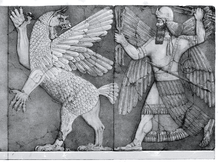Anu
| Anu | |
|---|---|
| Sky Father, King of the Gods, Lord of the Constellations | |
| Consort | Nammu, Uras |
| Parents |
Earliest texts:Not specified Later views:Anshar and Kishar |
| Children | Enki, Nikikurga, Nidaba, Enlil, Baba |
| Army | Deities and Stars |
| Part of a series on |
| Ancient Mesopotamian religion |
|---|
 |
|
Demigods and heroes |
| Related topics |
Anu (in Akkadian; Sumerian: An, from 𒀭An "sky, heaven") is the earliest attested Sky Father deity. In Sumerian religion, he was also "King of the Gods", "Lord of the Constellations, Spirits and Demons", and "Supreme Ruler of the Kingdom of Heaven", where Anu himself wandered the highest Heavenly Regions. He was believed to have the power to judge those who had committed crimes, and to have created the stars as soldiers to destroy the wicked. His attribute was the Royal Tiara. His attendant and vizier was the god Ilabrat.[1]
Sumerian religion
Anu existed in Sumerian cosmogony as a dome that covered the flat earth; Outside of this dome was the primordial body of water known as Nammu (not to be confused with the subterranean Abzu).[2]
In Sumerian, the designation "An" was used interchangeably with "the heavens" so that in some cases it is doubtful whether, under the term, the god An or the heavens is being denoted. The Akkadians inherited An as the god of heavens from the Sumerian as Anu-, and in Akkadian cuneiform, the DINGIR character may refer either to Anum or to the Akkadian word for god, ilu-, and consequently had two phonetic values an and il. Hittite cuneiform as adapted from the Old Assyrian kept the an value but abandoned il.
Divine genealogy and syncretisms
The earliest texts make no reference to An's origins. Later he is regarded as the son of Anšar and Kišar, as in the first millennium creation epic Enūma eliš [aka THE ENUMA ELISH](Tablet I, 11-14). In Sumerian texts of the third millennium the goddess Uraš is his consort; later this position was taken by Ki, the personification of earth, and in Akkadian texts by Antu, whose name is probably derived from his own.
An/Anu frequently receives the epithet "father of the gods," and many deities are described as his children in one context or another. Inscriptions from third-millennium Lagaš name An as the father of Gatumdug, Baba and Ningirsu. In later literary texts, Adad, Enki/Ea, Enlil, Girra, Nanna/Sin, Nergal and Šara also appear as his sons, while goddesses referred to as his daughters include Inana/Ištar, Nanaya, Nidaba, Ninisinna, Ninkarrak, Ninmug, Ninnibru, Ninsumun, Nungal and Nusku. An/Anu is also the head of the Annunaki, and created the demons Lamaštu, Asag and the Sebettu. In the epic Erra and Išum, Anu gives the Sebettu to Erra as weapons with which to massacre humans when their noise becomes irritating to him (Tablet I, 38ff).
When Enlil rose to equal or surpass An in authority, the functions of the two deities came to some extent to overlap. An was also sometimes equated with Amurru, and, in Seleucid Uruk, with Enmešara and Dumuzi.
Assyro-Babylonian religion
The doctrine once established remained an inherent part of the Babylonian-Assyrian religion and led to the more or less complete disassociation of the three gods constituting the triad from their original local limitations. An intermediate step between Anu viewed as the local deity of Uruk, Enlil as the god of Nippur, and Ea as the god of Eridu is represented by the prominence which each one of the centres associated with the three deities in question must have acquired, and which led to each one absorbing the qualities of other gods so as to give them a controlling position in an organized pantheon. For Nippur we have the direct evidence that its chief deity, En-lil, was once regarded as the head of the Sumerian pantheon. The sanctity and, therefore, the importance of Eridu remained a fixed tradition in the minds of the people to the latest days, and analogy therefore justifies the conclusion that Anu was likewise worshipped in a centre which had acquired great prominence.
The summing-up of divine powers manifested in the universe in a threefold division represents an outcome of speculation in the schools attached to the temples of Babylonia, but the selection of Anu, Enlil (and later Marduk), and Ea for the three representatives of the three spheres recognized, is due to the importance which, for one reason or the other, the centres in which Anu, Enlil, and Ea were worshipped had acquired in the popular mind. Each of the three must have been regarded in his centre as the most important member in a larger or smaller group, so that their union in a triad marks also the combination of the three distinctive pantheons into a harmonious whole.
In the astral theology of Babylonia and Assyria, Anu, Enlil, and Ea became the three zones of the ecliptic, the northern, middle and southern zone respectively. The purely theoretical character of Anu is thus still further emphasized, and in the annals and votive inscriptions as well as in the incantations and hymns, he is rarely introduced as an active force to whom a personal appeal can be made. His name becomes little more than a synonym for the heavens in general and even his title as king or father of the gods has little of the personal element in it. A consort Antum (or as some scholars prefer to read, Anatum) is assigned to him, on the theory that every deity must have a female associate. But Anu spent so much time on the ground protecting the Sumerians he left her in Heaven and then met Innin, whom he renamed Innan, or, "Queen of Heaven". She was later known as Ishtar. Anu resided in her temple the most, and rarely went back up to Heaven. He is also included in the Epic of Gilgamesh, and is a major character in the clay tablets.
Family Tree
| Abzū | |||||||||||||||||||||||||||||||||||||||||||||||||
| Mummu | Tīama | ||||||||||||||||||||||||||||||||||||||||||||||||
| Laḫmu | Laḫamu | ||||||||||||||||||||||||||||||||||||||||||||||||
| Anšargal | Kišargal | ||||||||||||||||||||||||||||||||||||||||||||||||
| An | |||||||||||||||||||||||||||||||||||||||||||||||||||||||||||||||||||
| Ninḫursaḡ | Enki born to Namma | Ninkikurga born to Namma | Nidaba born to Uraš | Ḫaya | |||||||||||||||||||||||||||||||||||||||||||||||||||||||||||||||
| Ninsar | Ninlil | Enlil | |||||||||||||||||||||||||||||||||||||||||||||||||||||||||||||||||
| Ninkurra | Ningal maybe daughter of Enlil | Suen | Nergal maybe son of Enki | Ninurta maybe born to Ninḫursaḡ | Baba born to Uraš | ||||||||||||||||||||||||||||||||||||||||||||||||||||||||||||||
| Uttu | Inana maybe daughter of Enki | Dumuzī maybe son of Enki | Utu | Ninkigal married Nergal | |||||||||||||||||||||||||||||||||||||||||||||||||||||||||||||||
| Meškiaḡḡašer | Banda | Ninsumun | |||||||||||||||||||||||||||||||||||||||||||||||||||||||||||||||||
| Enmerkar | Gilgāmeš | ||||||||||||||||||||||||||||||||||||||||||||||||||||||||||||||||||
| Urnungal | |||||||||||||||||||||||||||||||||||||||||||||||||||||||||||||||||||
See also
Notes
References
- Jordan, Michael (1993). Encyclopedia of Gods: Over 2,500 Deities of the World. New York: Facts on File, Inc. ISBN 978-0-8160-2909-9.
- Kramer, Samuel N. Sumerian Mythology: a Study of Spiritual and Literary Achievement in the Third Millennium B.C. Philadelphia: University of Pennsylvania Press, 1998.
-
 This article incorporates text from a publication now in the public domain: Chisholm, Hugh, ed. (1911). "Anu". Encyclopædia Britannica (11th ed.). Cambridge University Press.
This article incorporates text from a publication now in the public domain: Chisholm, Hugh, ed. (1911). "Anu". Encyclopædia Britannica (11th ed.). Cambridge University Press. - An/Anu (god)Mesopotamian sky-god, one of the supreme deities; known as An in Sumerian and Anu in Akkadian. http://oracc.museum.upenn.edu/amgg/listofdeities/an/
External links
| Wikisource has the text of the 1911 Encyclopædia Britannica article Anu. |
